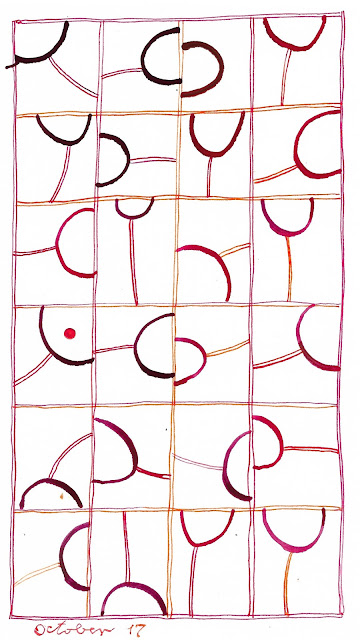It's been a while since I caught up with the comments that you all have left on the blog.
I've gotten many comments on my snarky remarks about the Designer DIY series in the New York Times, which has appeared on and off on Thursdays since springtime. It disappeared for a few months in late summer, reappeared for two weeks this month, and then was AWOL this past week -- I hope for good.
Shannon spoke for many of my readers when she said "the horribleness of these makes me think surely they are tongue-in-cheek, yet they seem so self-serious..." Marilyn wrote: "I'm on a news fast this weekend, the news is so miserable, and this is a perfect antidote. Funny! Do you think anyone really makes these things?"
Several people snarked at the "ironic Amish" designer who would have us cut up pillowcases to make dresses. Shasta wrote: "This is a good way to make clothes when you are under 9 and haven't figured out how to use the sewing machine yet. I am still trying to figure out 'ironic.' My nephew took my old TV for his dorm room because he said it was ironic." LES wrote: "My parents were Amish as children, and I can tell you, that ain't Amish, ironic or not. Pillowcase dresses are for 3-5 yr olds, not grown women. Once again, thanks for the laughs!"
Rena wrote: "Thoroughly enjoyed your critique. First gut-busting laugh this year. Would be fun to see photos from NYT readers modeling their pillowcase creations..."
And yet... I got an email from my friend Susan who said, "But the truth is, when I was in my teens, and much scrawnier than now, I did make a few sleeveless summer dresses out of (not very worn) king sized pillow cases. I opened up the seams at the top center and top of each side, and then used the seam allowances as facings for the boat neck and armholes... and they came pre-hemmed. Thanks for the memories!"
Several readers have commented over the months of the Designer DIY feature that I could do the job better than the editor/writer. I will modestly point out that it's much easier to make fun of the finished product than it no doubt was to wrangle articles out of prima donna designers who clearly have no idea of how to actually make something. But thank you for your kind thoughts! Norma wrote: "Kathy, I love reading your critiques of these articles. Can there really be an editor that approves of these?" Bea wrote: "You might compile these blogs in a book and send to the Times?"
Bea, I'm way ahead of you. During the summer I wrote a long message to Vanessa Friedman, the fashion editor of the Times, pointing out how lame this series has been. I sent links to all the blog posts I had done to date and begged her to pull the plug on the series. "If your purpose in this series is to win brownie points in the fashion community and give some designers a bit of free ink, then you have probably succeeded, especially among readers who don't actually try to do the projects. But if your purpose is to give your readers projects they can succeed at and feel proud of, your are failing miserable," I wrote. "I apologize for the snarky tone of these posts, but Ms. Friedman, you have certainly asked for it. Properly executed, this could be a wonderful series. But instead it's a laughingstock among people who know sewing, embroidery and crafts. And probably it's a great disappointment among people who don't, and looked to you for guidance that didn't work."
I suggested that she let people who know how to do handwork write the instructions, or "better yet, let somebody who does actual handwork come up with the ideas too, so you could present projects that are doable and attractive."
I received no response, of course. I have spent a little time thinking about what kinds of projects I could dream up for housebound readers with little or no experience in sewing or working with fabric if indeed I were running this project. Easier said than done, especially when you realize that most people out there, unlike you and me, don't possess fabric, needles, thread, embroidery hoops, pins, sewing machines or any of the huge array of stuff that makes our projects possible. Nor can a lot of them sashay down to the local fabric store and stock up.
So what projects would you recommend if you were in charge?
 I've done this in the past, made something that seemed great the first time around but never as good again, no matter now many times I revisit it. Maybe that's because I love to work improvisationally, without the safety net of sketching or a lot of planning ahead. So when I come back and do the same motif again, it seems constrained and artificial rather than serendipitous. What do you think? Have you had a similar experience?
I've done this in the past, made something that seemed great the first time around but never as good again, no matter now many times I revisit it. Maybe that's because I love to work improvisationally, without the safety net of sketching or a lot of planning ahead. So when I come back and do the same motif again, it seems constrained and artificial rather than serendipitous. What do you think? Have you had a similar experience?




































